“Byzantine Women and Their World” Exhibit at Harvard’s Arthur M. Sackler Museum
First U.S. Exhibit to Explore the Role of Byzantine Women in Public and Private Spheres through Works of Art
***
Opening at the end of October, this exhibit at the Arthur M. Sackler Museum of Harvard University accomplishes the goals it set out to achieve: to explore the daily lives of women in the Byzantine world and to initiate a “fresh discourse . . . by displaying a variety of works of art and other objects and images related to them and their everyday lives.” Filling several rooms, the artefacts of this exhibit speak directly to viewers about women who lived during the many centuries of the Byzantine period.
This exhibit departs from the viewpoint traditionally taken by exhibitions of Byzantine art which focus on the spirituality and splendor of the empire. “Byzantine Women and Their World” instead examines their daily activities by presenting “all facts of the female experience—religious and secular, public and private, noblewoman and commoner.” The theme of “Women at Work” links the two major categories of objects, public and private. The public sphere focuses on “female images of authority, such as empresses, the Virgin Mary, female saints, and personifications of cities.” Objects reflecting the private lives of Byzantine women depict women working at home, spinning and weaving, or engaging in activities related to marriage, home, and adornment.
|
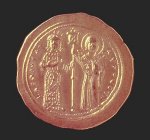 |
|
Theodora. Empress of Byzantium. Gold Histamenon of Theodora, Byzantine, 1055-1056. Gold, 2.5 cm, wt. 4.43 g. Courtesy of the Arthur M. Sackler Museum, Harvard University Art Museum. Bequest of Thomas Whittemore, 1951.31.4.1586.
|
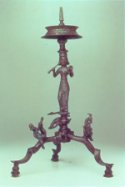 |
Organized by Dr. Ioli Kalavrezou, Dumbarton Oaks Professor of Byzantine Art in the Department of History of Art and Architecture, the collection includes nearly 200 objects from the Sackler Museum and other major institutions, among them the Metropolitan Museum of Fine Art, the Boston Museum of Fine Arts, the Walters Art Museum in Baltimore, the Virginia Museum of Fine Arts, the Morgan Library in New York, and the Royal Ontario Museum in Canada. The exhibit pieces range in date from the fourth through the fifteenth century, the span of the Byzantine Empire. From faraway and exotic locales like Egypt, Asia Minor, Constantinople, and Russia, these artefacts represent a full range of media and subject matter. Luxury objects, such as ivories, silver vessels, exquisite jewelry, official gold coins, as well as utilitarian objects, such as combs, mirrors, weaving tools, and textiles, fill the august spaces of the museum alongside ritual amulets and ecclesiastical icons.
|
|
Candelabrum with Aphrodite, Egyptian, 5th-6th century. Bronze, 50.8 x 30.5 x 25.4 cm. Courtesy of The Nelson-Atkins Museum of Art, Kansas City, MI (Purchase: Nelson Trust) 58-5.
|
Through the objects, viewers can detect a lingering tradition linked to the Classical era. Images of Olympian gods and other ancient figures still adorn lamp stands and wedding belts, well into the middle Byzantine era.
Christian images and themes abound, sometimes alongside the Classical images in secular objects. Items relating to marriage, home, and religion fill the exhibit hall, delineating parameters of the women’s sphere of activity. Striking icons depict devotional activity of women, another aspect of the woman’s world. Patches of intricately woven materials reveal the consummate skills of Byzantine weavers, while the designs and functions of the woven objects continue to inform viewers about the activities, thoughts, and desires of women. Some of the fabric pieces depict female portraits; others, traditional designs modeled after the natural world. Sewing and weaving tools accompany some fabrics, while women’s toiletries and kitchenware constitute other clusters of skillfully organized artefacts. Statuettes and busts with elaborate hair arrangements reveal the garb and accoutrements of aristocratic women of high society. Coins and official seals round out the range of activities of women depicted in this exhibit, reminding viewers of the role played by aristocratic and ruling women during the Byzantine era.
The prominence of women in the daily life of the Byzantine Empire strikes viewers with clarity. From traditional activities at home—spinning, weaving, sewing, cooking, tending house—to the powerful voices of female rulers and aristocrats, the roles of Byzantine women have never been more carefully depicted. The first of its kind anywhere in the U.S., this exhibit blazes a pioneering trail. For viewers gain a better understanding of the versatility and range of women’s activities.
|
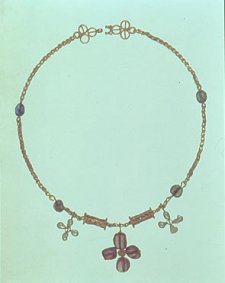 |
|
Necklace, Early Byzantine, late 5th-6th century. Gold, emerald, amethyst, and pearls, L. 39.85 cm. Courtesy of the Indiana University Art Museum, Boomington, IN: Burton Y. Berry Collection, 70.56.12.A.
|
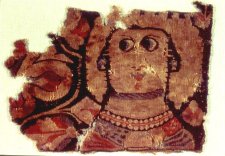 |
|
Fragments of a Textile Hanging with Female Busts, Coptic, 6th-7th centuries A.D. 77 x 18 cm. Courtesy of the Arthur M. Sackler Museum, Harvard University Art Museums, Gift of The Hagop Kevorkian Foundation in memory of Hagop Kevorkian, 1975.41.23.
|
In a society generally considered to be patriarchal—and where “patiarchal” often equals “restrictive”—these remarkable women’s objects demonstrate quite the opposite, that Byzantine women, collectively, engaged in a wide range of activities.
Exhibit catalogs will be available in March 2003; persons interested in reserving copies may contact the Sale Department of Harvard University Art Museum at 32 Quincy St., Cambridge, MA 02138, tel. 617-495-8286. The catalog, by Dr. Kalavrezou, with contributions and introductory essays by leading Byzantinists, will run 272pp, including 150 black-and-white photos and colorplates, and cost $40.00, not including shipping charges.
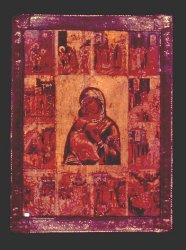 |
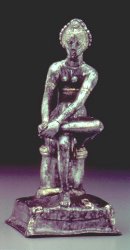 |
This fine exhibit titled, “Byzantine Women and Their World,” will run until April 28, 2003 at the Arthur M. Sackler Museum in Cambridge. Located at 485 Broadway, in the heart of the Harvard Square area, museum hours are Monday through Saturday, 10 am—5 pm, except holidays (closed Nov. 28, Dec. 24, 25, 31, Jan. 1); Sunday, 1-5 pm. Admission is $6.50; $5.00 seniors and students; children under 18, Friends of the Museums, Cambridge Public Library cardholders, and Harvard students and staff enter free of charge. The museums are free to everyone Saturday mornings, 10 am until noon. |
Above Left: The Virgin of Vladimir with 12 Scenes from the Legend of the Miracles of the Icon of the Virgin of Vladimir, Russian, 1750-1760. Tempera on panel with silver, 71.76 x 55.25 x 3.81 cm. Courtesy of the Fogg Art Museum, Harvard University Art Museums, Bequest of Philip M. Lydig, 1930.43.
Above Right: Seated Dancer, Roman, Late Roman Imperial/Early Byzantine Period, late 4th century. Silver with gold details, H. 12 cm. Frederick Brown Fund, Courtesy, Museum of Fine Arts, Boston, MA, 69.72.
|
For more information, contact the museum at 617-495-9400 or visit the website at www.artmuseums.harvard.edu. A docent-leg tour of this exhibit will be conducted on Wednesday, Dec. 18, 2003 at 12:15 pm. For additional information, contact the museum directly.
|






